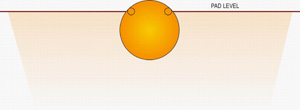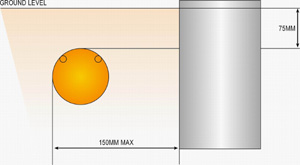Frequently asked questions
(FAQ)
Q. How do the Termguard
systems work?
A. They are unique in its design and enable an equal distribution
of solution within a 15% variation. The design of the pipe
and the placement of the holes in the pipes create a reservoir
that enables the whole system to fill prior to any solution
dispersing from the holes.
These diagrams show the placement of the holes in a cross
section view.
 |
 |
The holes are placed in the top 20% of the pipe and are installed
facing upwards. This enables the system pipe to fill totally
before beginning to emit any solution.
This also is how the systems deliver such an equal distribution
of solution. A solution pumped through a perforated pipe will
follow the path of least resistance. Therefore, in a simple
reticulation system of perforated pipes, the pressure at the
first hole along a pipe will be higher and therefore more
solution will flow through the first hole compared to the
last hole along the same system.
This presents problems for delivering equal amounts of solution.
Termguard has solved this problem by adding a manifold that
equilibrates the pressure at all the holes in the system to
deliver equal amounts of solution from the first through the
last holes.
Q. How are the holes in the perforated perimeter pipe
kept free from obstructions, especially construction fill?
A. By the use of Permecover – a GeoFabric non-woven
mat that keeps the construction fill from blocking the perforated
pipe. Permecover also contains the termite management agent
within those areas of construction that require a termite
management barrier.
The use of clean unwashed
sand/soil is used with the placement of the pipe with less
than 10% rock content, which provides for equitable movement
of the delivered termite management agent.
If small particles of sand/soil enter into the pipe trough
the perforations the next delivery of termite control agent
will push the soil particle to the end of the run of pipe
where a drilled end cap will allow it to pass out of the system.
Q. What is the placement depth of the system?
A. The correct placement of the 3/4” perforated pipes
is essential for the Termguard System to work. The requirement
for pipes placed under the slab is different from the placement
of the Termguard Perimeter System. The perforated pipes that
are placed under the slab must be installed with at least
80% of the pipe below the finished pad level and the holes
in the pipe must be facing upwards.
 |
The Termguard Perimeter System is installed
below the finished ground level and with a Permecover sleeve.
The pipe is placed approximately 3” below the finished
ground level and must be within 6" from the edge of the
footing or brickwork. The holes in the drilled pipe must also
be facing upwards for the system to deliver an equal dispersion
of Termite Management Agent.
 |
Q. Is the structural performance or integrity of slab construction
affected by the impact of the appropriate volume of liquid
when applied through Termguard systems?
A. No, the performance and integrity of the slab would not
be affected, because the maximum volume of liquid that is
put through the Termguard System at any one time never exceeds
1 gallon per 10 square feet of soil area. This application
rate is equivalent to 0.2 inches of rainfall and will only
be applied on a 3 to 5 year basis. Trials have been conducted
on even the heaviest of reactive soils and the volume applied
by the Termguard systems were insignificant to soil moisture
conditions caused by rain from season to season.
Q. Do the termite management agents effectively bind
to the target areas and not leach from the desired areas of
treatment even if subsequent wetting occurred?
A. From an environmental standpoint, Termguard systems are
the perfect choice for keeping termites out of the home or
building. The termite management agents used are insoluble
in the soil, so the barrier stays exactly where it is needed
and will not be leached away by rainfall or the water in of
lawns and gardens.
The termite management agents, approved by Termguard, for
use within the system are non-systemic, which means that garden
plants and other vegetation will not translocate the barrier
away from the treated area where it is most needed.
Q. Does the termite management agent affect the home/building
owner’s family and pets?
A. All termite management agents approved for use in Termguard
Systems are manufactured in accordance with the highest EPA
specifications relating to termite management products.
Most importantly, they bring real 'peace of mind' protection
with the knowledge that it will not create health concerns
for the building owner, family or pets and are environmentally
responsible.
Termguard appreciate that some people can be severely allergic
to prescribed medication and/or a variety of household products
such as washing detergents, paints, insecticides or even cosmetic
items. Termguard also recognize that personal medical conditions
need to be taken into account at the time of termite management
applications.
Q. Does the home/building owner have to be present
when replenishing the termite management agent?
A. Another of the unique features of the Termguard Systems
is that all systems are injected or replenished via external
injection points which are located in the pathway or garden
bed or landscaping of the building and are protected by a
locked child proof trap. Therefore, the home or building owner
is not required to be present at the time of replenishment
however; all inspections require full internal and external
access to the building.
 |
|
Q. How often is the home/building owner required to
have the system inspected?
A. It is highly recommend that inspections be undertaken at
least 12 monthly and 3 to 6 monthly in high-risk termite areas.
These recommendations relate to all termite management systems.
The manufacturer’s of termite management agents have
varying times recommended for replenishment of their product,
but experience shows that Termguard Systems should be replenished
at least every 3 to 5 years. The licensed Termguard inspector
will be able to determine when the replenishment should be
undertaken when inspecting the property.
Q. What costs are involved in maintaining the systems?
A. The cost of maintaining the system is far outweighed by
the potential damage termite activity can cause to the home/building.
To maintain any warranty provided, regular Timber Pest Inspections
need to be undertaken and these costs are relatively inexpensive
in comparison to the piece of mind they provide to the owner.
Replenishment of the Termguard System will occur every few
years and once again, these costs are miniscule in comparison
to the costs incurred in repairing damage caused by termite
activity to the building and are far more economical and less
disruptive than the traditional methods used when retrenching
soils areas and re-drilling externals paths and concrete areas.
Q. Can the Annual Inspections or Replenishment of
Termguard Systems be carried out by the home/building owners’
choice of Pest Manager?
A. The Termguard Systems can be inspected or replenished by
a professional pest manager of your choice, but due to the
unique features of the systems, only licensed Termguard inspectors
have:
• Details of how the system was originally installed,
• Dimensions of the system,
• Amount of termite management agent originally applied,
• Amount required for replenishment
• Been trained in the injection protocols, which include
the use of specialized injection equipment.
The Termguard warranty will only respond if licensed Termguard
inspector’s carry out the inspections and replenishment.
Q. Is it difficult to audit or monitor the amount
of termite management agent dosed underground through reticulated
systems hidden beneath buildings, which could pollute the
underground water?
A. The development of current and future termite management
agents have and must continue to meet the criteria of being
stable within their environment and ensure that they bind
to the soil. There has been NO underground water issues in
relation to the Termguard System in Australia, particularly
as all Termguard Licensees only use termite management agents
which have proved stability in relation to soil binding and
water table issues and are approved and tested by Termguard
for use within the Termguard Systems. Various new products
are always being designed specifically for treatment and reapplication
through reticulated systems and Termguard undertakes an ongoing
testing program to ensure efficacy of these termite management
agents.
Q. What happens if only one section of the perimeter
is disturbed during landscaping, construction or other means?
A. Only that section of the Termguard System, which has been
disturbed needs to be retreated or re-injected, therefore
maintaining the integrity of the Termguard System and minimizing
the cost to replenish the total system(s) installed at any
particular building.
Q. What happens if the Termguard System has been out
of warranty for some time due to lack of regular inspections
or not being replenished? Can the Termguard Warranty be reinstated?
A. Yes! The structure must have a full Timber Pest Inspection
& Report in accordance with local regulatory recommendations
and completed by a licensed Termguard Inspector. If the building
is found clear of any termite activity, the Termguard System
can be reinjected and the warranty reinstated as of the initial
injection date.
Q. What happens if the home/building owner wishes
to raise soil levels around the building?
A. The Termguard System can easily be adjusted and once the
disturbed section is reinjected, the Warranty will continue.
Q. What happens if a section of the Termguard System
is accidentally damaged?
A. That section can be either replaced or in the case of a
break or fracture of the pipe, the damage can be easily repaired
and the Termguard System reinstated.
Q. What happens if the licensed Termguard installer
is no longer in business?
A. The home/building owner will be put into contact with other
Termguard Licensed Installers in the territory. Once another
Termguard Licensed Installer is selected to maintain the Termguard
System, the installation details will be provided to them
from Termguard records.
Q. How do I become a Termguard Licensed Installer?
A. In order to become a Termguard Licensee your company must
be fully licensed in the respective state for termite control
and/or currently be involved in the pretreat for termites
in new construction.
Q. Is there any capital investment required to become
a Termguard Licensed Installer?
A. Yes. In order to become a part of the Termguard team, a
prospective licensee agrees to pay a license fee, which provides
access to the following:
• Termguard piping and fittings, invoiced separately
on a per shipment basis
• Training program for all installers and field quality
inspectors
• Access to the Termguard Intranet Website
• Technical support for design, quotation and installation
of the systems
• Marketing support for presentation to builders, regulators,
architects, certifiers, etc.
• Comprehensive installation manual
• Training video
• Technical information CD ROM
For more information contact:
Ken Glover
1-888-652-2345
|
